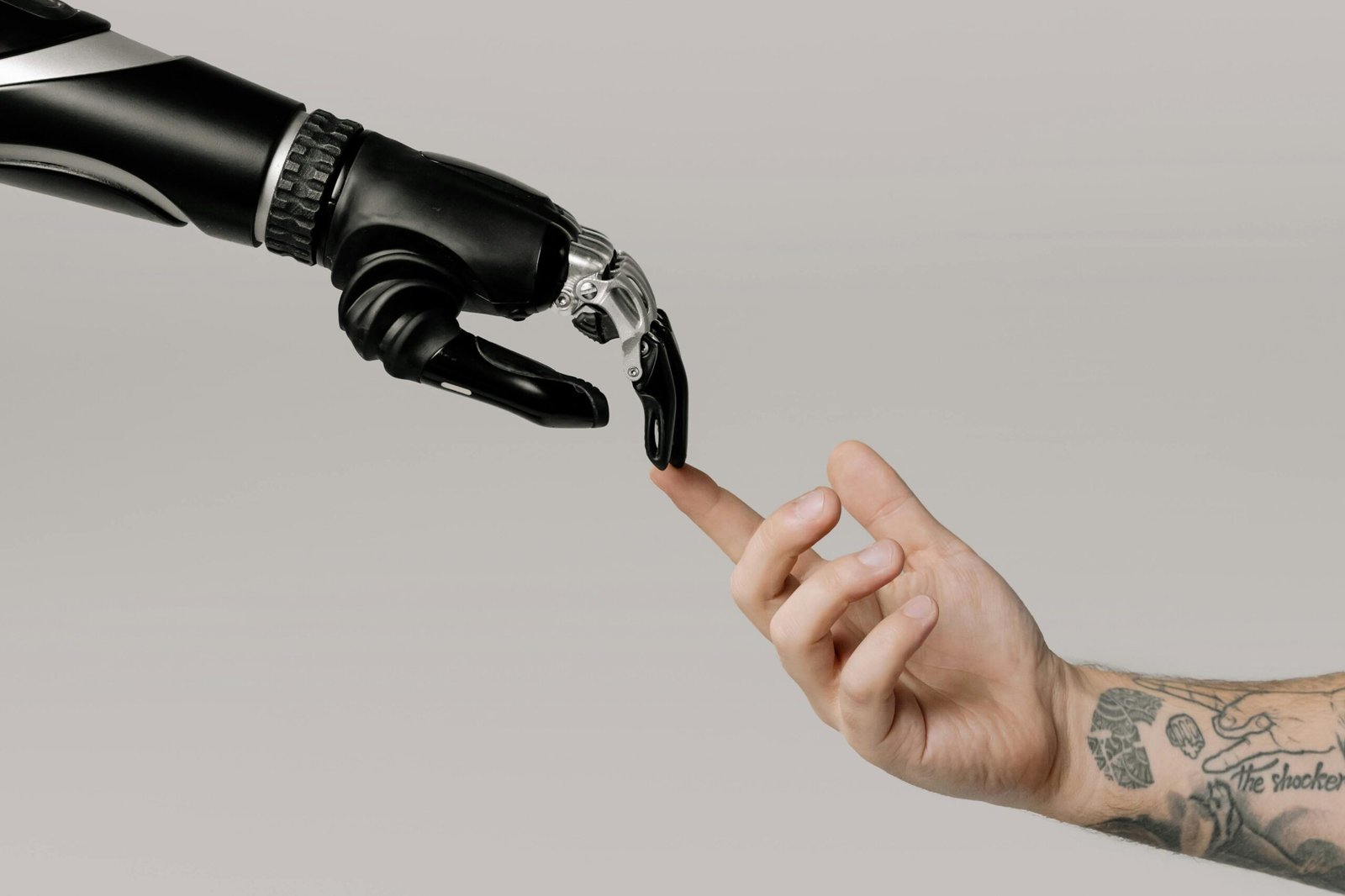The Impact of Artificial Intelligence on the Future of Work

Introduction
Artificial intelligence (AI) is transforming industries and reshaping the future of work at an unprecedented pace. From automating routine tasks to enhancing decision-making processes, AI is set to revolutionize the way we work, bringing both opportunities and challenges. This article explores the multifaceted impact of AI on the future of work, examining its potential benefits, the challenges it presents, and the strategies needed to navigate this transformative landscape.
Outline
1. Understanding Artificial Intelligence
– Definition and Types of AI
– Evolution of AI Technologies
2. AI’s Role in Automating Tasks
– Automation of Routine and Repetitive Tasks
– Advanced Automation in Complex Industries
– Case Studies of AI-Driven Automation
3. Enhancing Decision-Making with AI
– AI in Data Analysis and Insights
– Predictive Analytics and Forecasting
– AI-Powered Decision Support Systems
4. Transforming Workforce Dynamics
– Job Displacement and Creation
– Changing Skill Requirements
– Remote Work and AI Tools
5. AI in Different Sectors
– Healthcare
– Finance
– Manufacturing
– Retail
6. Challenges and Ethical Considerations
– Data Privacy and Security
– Bias and Fairness in AI
– Job Displacement and Economic Impact
– Ethical AI Development and Governance
7. Preparing for the AI-Driven Future
– Reskilling and Upskilling the Workforce
– Lifelong Learning and Education
– Policy and Regulatory Frameworks
– Collaboration Between Stakeholders
8. Case Studies and Real-World Applications
– Successful AI Implementations
– Lessons Learned from Early Adopters
9. Conclusion
Understanding Artificial Intelligence
Definition and Types of AI
Artificial intelligence refers to the simulation of human intelligence in machines that are programmed to think and learn like humans. AI can be categorized into two main types:
– Narrow AI (Weak AI): Designed for specific tasks such as language translation, facial recognition, and recommendation systems.
– General AI (Strong AI): A theoretical form of AI that possesses the ability to perform any intellectual task that a human can do, with an understanding and cognitive abilities equivalent to human beings.
Evolution of AI Technologies
AI has evolved significantly over the past few decades, driven by advancements in computing power, data availability, and algorithmic improvements. Key milestones include:
– 1950s-1960s: Early AI research focused on symbolic AI and rule-based systems.
– 1980s-1990s: Emergence of machine learning and neural networks.
– 2000s-Present: Rise of deep learning, natural language processing, and reinforcement learning.
These advancements have enabled AI to become more sophisticated and capable of performing a wider range of tasks.
AI’s Role in Automating Tasks
Automation of Routine and Repetitive Tasks
AI excels at automating routine and repetitive tasks, freeing up human workers to focus on more complex and creative endeavors. Examples of such tasks include:
– Data Entry: AI-powered systems can automatically input, process, and manage data, reducing the need for manual data entry.
– Customer Support: Chatbots and virtual assistants can handle basic customer inquiries, providing instant responses and improving customer satisfaction.
– Inventory Management: AI-driven systems can monitor inventory levels, predict demand, and reorder supplies automatically.
Advanced Automation in Complex Industries
AI is also making significant strides in automating more complex tasks in various industries. For example:
– Manufacturing: AI-driven robots and machinery can perform precise tasks, such as assembly and quality control, with high efficiency and accuracy.
– Healthcare: AI-powered diagnostic tools can analyze medical images and patient data to assist doctors in making accurate diagnoses and treatment plans.
– Finance: AI algorithms can analyze market trends, detect fraudulent activities, and optimize investment strategies.
Case Studies of AI-Driven Automation
– Amazon: The company uses AI-powered robots in its fulfillment centers to streamline the picking and packing process, reducing delivery times and operational costs.
– Tesla: Tesla’s manufacturing plants utilize AI-driven automation for vehicle assembly, improving production efficiency and quality.
– IBM Watson: Watson for Oncology uses AI to analyze patient data and medical literature to provide oncologists with evidence-based treatment recommendations.
Enhancing Decision-Making with AI
AI in Data Analysis and Insights
AI has revolutionized data analysis by enabling organizations to process and analyze vast amounts of data quickly and accurately. AI-driven data analysis can uncover patterns, trends, and insights that were previously hidden, allowing businesses to make more informed decisions.
Predictive Analytics and Forecasting
Predictive analytics, powered by AI, uses historical data to predict future outcomes. This capability is particularly valuable in industries such as finance, healthcare, and retail, where accurate forecasting can lead to better resource allocation, risk management, and strategic planning.
AI-Powered Decision Support Systems
AI-powered decision support systems (DSS) assist managers and executives in making complex decisions by providing relevant data, insights, and recommendations. These systems leverage machine learning algorithms to analyze data and generate actionable insights, improving decision-making accuracy and speed.
Transforming Workforce Dynamics
Job Displacement and Creation
AI is reshaping the workforce by automating certain jobs while creating new opportunities. While some routine and repetitive tasks are being automated, AI is also driving demand for new roles in AI development, data science, and digital transformation.
Changing Skill Requirements
As AI continues to evolve, the skills required in the workforce are also changing. There is a growing demand for skills in AI, machine learning, data analysis, and cybersecurity. Soft skills such as critical thinking, creativity, and emotional intelligence are also becoming increasingly important as humans collaborate with AI systems.
Remote Work and AI Tools
The COVID-19 pandemic accelerated the adoption of remote work, and AI has played a crucial role in supporting this shift. AI-powered tools such as virtual meeting platforms, project management software, and collaboration tools have enabled remote teams to stay connected and productive.
AI in Different Sectors
Healthcare
AI is revolutionizing healthcare by improving diagnostics, treatment, and patient care. Applications include:
– Medical Imaging: AI algorithms can analyze medical images with high accuracy, assisting radiologists in detecting diseases such as cancer.
– Personalized Medicine: AI can analyze genetic and clinical data to develop personalized treatment plans tailored to individual patients.
– Virtual Health Assistants AI-powered chatbots and virtual assistants can provide patients with medical information, appointment scheduling, and medication reminders.
Finance
AI is transforming the finance industry by enhancing risk management, fraud detection, and customer service. Applications include:
– Algorithmic Trading: AI algorithms can analyze market data and execute trades at high speeds, optimizing investment strategies.
– Fraud Detection: AI can detect unusual patterns and behaviors in financial transactions, helping to identify and prevent fraudulent activities.
– Customer Service: AI-powered chatbots and virtual assistants can handle customer inquiries, provide financial advice, and streamline account management.
Manufacturing
AI is driving innovation in manufacturing by improving production efficiency, quality control, and supply chain management. Applications include:
– Predictive Maintenance: AI algorithms can analyze data from sensors and machinery to predict equipment failures and schedule maintenance, reducing downtime and costs.
– Quality Control: AI-powered vision systems can inspect products for defects with high precision, ensuring consistent quality.
– Supply Chain Optimization: AI can analyze supply chain data to optimize inventory levels, reduce lead times, and improve overall efficiency.
Retail
AI is transforming the retail industry by enhancing customer experiences, optimizing operations, and driving sales. Applications include:
– Personalized Recommendations: AI algorithms can analyze customer data to provide personalized product recommendations, increasing sales and customer satisfaction.
– Inventory Management: AI-driven systems can predict demand, manage stock levels, and automate reordering processes.
– Customer Insights: AI can analyze customer behavior and preferences to provide valuable insights for marketing and product development.

Challenges and Ethical Considerations
Data Privacy and Security
The widespread use of AI involves the collection and analysis of vast amounts of data, raising concerns about data privacy and security. Ensuring that sensitive information is protected and used ethically is crucial. Organizations must implement robust data protection measures and comply with regulations such as GDPR and CCPA to safeguard user data.
Bias and Fairness in AI
AI algorithms can inadvertently perpetuate biases present in the training data, leading to unfair outcomes. Ensuring fairness and mitigating bias in AI systems is a significant challenge. Researchers and developers must prioritize transparency, fairness, and accountability in AI development to prevent discrimination and ensure equitable outcomes.
Job Displacement and Economic Impact
The automation potential of AI raises concerns about job displacement and the future of work. While these technologies create new opportunities, they also threaten to displace workers in various industries. Policymakers, educators, and businesses must work together to reskill and upskill the workforce to adapt to the changing job landscape.
Ethical AI Development and Governance
The rapid advancement of AI necessitates the development of comprehensive regulatory frameworks to address ethical, legal, and societal implications. Governments and international bodies must collaborate to create policies that promote innovation while ensuring the responsible and ethical use of AI technologies.
Preparing for the AI-Driven Future
Reskilling and Upskilling the Workforce
To prepare for the AI-driven future, it is essential to invest in reskilling and upskilling the workforce. This involves providing training and education programs that equip workers with the skills needed to thrive in an AI-enhanced job market. Governments, educational institutions, and businesses must collaborate to create accessible and relevant learning opportunities.
Lifelong Learning and Education
The rapid pace of technological change requires a shift towards lifelong learning. Continuous education and skill development are
crucial to staying competitive in the evolving job market. Emphasizing STEM (Science, Technology, Engineering, and Mathematics) education, as well as soft skills, will be vital in preparing individuals for the future of work.
Policy and Regulatory Frameworks
Governments must develop and implement policies that address the challenges and opportunities presented by AI. This includes creating regulatory frameworks that ensure data privacy, promote ethical AI development, and support workforce transition. Policymakers must also encourage public-private partnerships to foster innovation and economic growth.
Collaboration Between Stakeholders
Collaboration between various stakeholders, including governments, businesses, academia, and civil society, is essential for navigating the AI-driven future. By working together, these stakeholders can develop strategies to address the challenges, leverage opportunities, and ensure that the benefits of AI are broadly shared.
Case Studies and Real-World Applications
Successful AI Implementations
– Google: Google uses AI across its products, from search algorithms to self-driving cars. AI-powered Google Assistant provides users with personalized assistance and information.
– Microsoft: Microsoft’s AI initiatives include Azure AI, a cloud-based platform that provides AI services for businesses, and Cortana, an AI-powered virtual assistant.
– Netflix: Netflix leverages AI to provide personalized content recommendations, optimize streaming quality, and manage content production.
Lessons Learned from Early Adopters
Early adopters of AI have demonstrated that successful implementation requires a clear strategy, investment in talent, and a focus on ethical considerations. Companies that prioritize transparency, fairness, and accountability in their AI initiatives are more likely to achieve positive outcomes and build trust with stakeholders.
Conclusion
Artificial intelligence is set to have a profound impact on the future of work, offering numerous opportunities for innovation, efficiency, and economic growth. However, it also presents significant challenges, including job displacement, ethical concerns, and the need for new skills. By understanding the implications of AI and proactively addressing these challenges, we can harness the potential of AI to create a more productive, equitable, and sustainable future of work. Collaboration between governments, businesses, educational institutions, and civil society will be essential in ensuring that the benefits of AI are widely shared and that the transition to an AI-driven world is smooth and inclusive.










